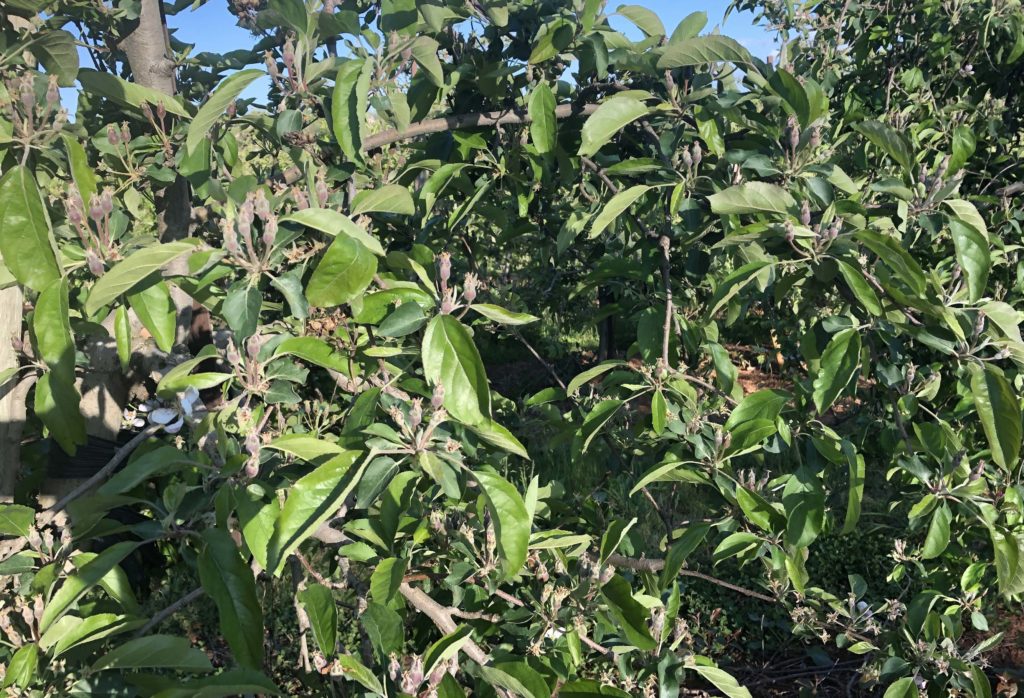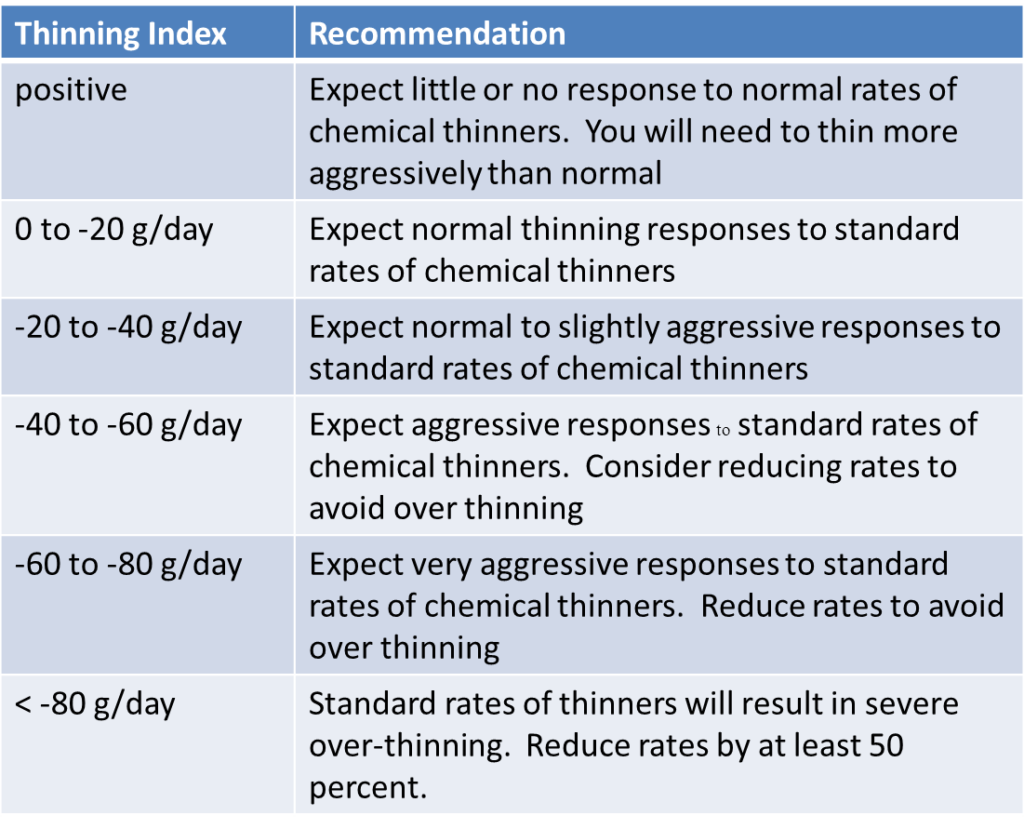Crop Load Management Update: 04/26/20
go.ncsu.edu/readext?682724
en Español / em Português
El inglés es el idioma de control de esta página. En la medida en que haya algún conflicto entre la traducción al inglés y la traducción, el inglés prevalece.
Al hacer clic en el enlace de traducción se activa un servicio de traducción gratuito para convertir la página al español. Al igual que con cualquier traducción por Internet, la conversión no es sensible al contexto y puede que no traduzca el texto en su significado original. NC State Extension no garantiza la exactitud del texto traducido. Por favor, tenga en cuenta que algunas aplicaciones y/o servicios pueden no funcionar como se espera cuando se traducen.
Português
Inglês é o idioma de controle desta página. Na medida que haja algum conflito entre o texto original em Inglês e a tradução, o Inglês prevalece.
Ao clicar no link de tradução, um serviço gratuito de tradução será ativado para converter a página para o Português. Como em qualquer tradução pela internet, a conversão não é sensivel ao contexto e pode não ocorrer a tradução para o significado orginal. O serviço de Extensão da Carolina do Norte (NC State Extension) não garante a exatidão do texto traduzido. Por favor, observe que algumas funções ou serviços podem não funcionar como esperado após a tradução.
English
English is the controlling language of this page. To the extent there is any conflict between the English text and the translation, English controls.
Clicking on the translation link activates a free translation service to convert the page to Spanish. As with any Internet translation, the conversion is not context-sensitive and may not translate the text to its original meaning. NC State Extension does not guarantee the accuracy of the translated text. Please note that some applications and/or services may not function as expected when translated.
Collapse ▲The post-bloom thinning window is well underway and several growers made thinner applications last week. Output from the Carbon Balance Model for four sites in western NC (Apple Wedge, Flat Rock, Sugarloaf, and Morganton) and two sites in North Georgia (Blue Ridge and Ellijay) is below (click figures to enlarge). Spring 2020 has been very challenging for chemical thinning across all sites, mostly due to unseasonably cool temperatures.
A continued carbon surplus is predicted for NC sites, but somewhat favorable temperatures for thinner activity are predicted on 4/28 (Tuesday). When using “normal product rates”, mild thinner activity was predicted for all NC sites over the past 3 weeks due to cool temperatures. Interestingly, the predicted “sweet spot” for tree susceptibility to chemical thinner activity (200 to 250 GDD after full bloom) aligns with applications made early this week.
GA sites appear to have a favorable thinning window early this week, due to predicted cloud cover and warm temperatures.
Running the Model
If you have access to NEWA, I highly recommend calculating the carbon balance for your own site. Predicted weather data is used in these estimates and the forecast can change throughout the course of a day. If you’d like to run the model on your own, the link at the NEWA site is on the drop-down menu under “Crop Management”. Choose a site nearest your orchard location and enter your Green Tip and Full Bloom date. If using the 2019 version of the model, select the % of flowering spurs that is most appropriate for the block(s) you plan to thin. Then select the green “Calculate” button.
It is very likely that if you run the model on your own, you will observe different and more accurate output. Potential reasons for this deviation in output includes:
1) Use of different model versions. I am reporting data from the 2019 version of the model and selected 50-75% flowering spurs.
2) Different green tip/bloom dates used.
3) Model output is based on forecast data, so the output will change as the forecast changes (a key incentive to run this on your own, if possible).
North Carolina
Edneyville, NC (Apple Wedge)
| 4.26.20: Edneyville (Apple Wedge) Apple Carbohydrate Thinning Model Results | |||||||
| Date | Max Temp | Min Temp | Solar Rad | Tree Carbohydrate Balance (g/day) | Accum. Degree Days | Thinning Rec. | |
| (°F) | (°F) | (MJ/m2) | Daily | 7-Day Ave | (since bloom) | – | |
| 26-Apr | 64 | 50 | 20.9 | 37.01 | 28.13 | 201.1 | Increase Chemical Thinning Rate by 30% |
| 27-Apr | 63 | 41 | 23.8 | 62.52 | 34.28 | 208.2 | Increase Chemical Thinning Rate by 30% |
| 28-Apr | 71 | 44 | 23.3 | 48.78 | – | 218.3 | – |
| 29-Apr | 68 | 49 | 11 | 3.96 | – | 229.1 | – |
| 30-Apr | 65 | 45 | 21.4 | 53.98 | – | 237.8 | – |
| 1-May | 66 | 47 | 23.7 | 56.77 | – | 247.4 | – |
Edneyville, NC (Sugarloaf Mtn)
| 4.26.20: Edneyville (Sugarloaf Mtn) Apple Carbohydrate Thinning Model Results | |||||||
| Date | Max Temp | Min Temp | Solar Rad | Tree Carbohydrate Balance (g/day) | Accum. Degree Days | Thinning Rec. | |
| (°F) | (°F) | (MJ/m2) | Daily | 7-Day Ave | (since bloom) | – | |
| 26-Apr | 63 | 47 | 20.4 | 27.14 | 18.35 | 186.8 | Increase Chemical Thinning Rate by 30% |
| 27-Apr | 63 | 42 | 24 | 45.87 | 21.75 | 194.2 | Increase Chemical Thinning Rate by 30% |
| 28-Apr | 70 | 44 | 23.3 | 31.62 | – | 204.1 | – |
| 29-Apr | 66 | 48 | 11 | -8.25 | – | 214 | – |
| 30-Apr | 65 | 45 | 21.5 | 35.89 | – | 222.7 | – |
| 1-May | 66 | 47 | 23.7 | 38.07 | – | 232.4 | – |
Flat Rock, NC
| 4.26.20: Flat Rock Apple Carbohydrate Thinning Model Results | |||||||
| Date | Max Temp | Min Temp | Solar Rad | Tree Carbohydrate Balance (g/day) | Accum. Degree Days | Thinning Rec. | |
| (°F) | (°F) | (MJ/m2) | Daily | 7-Day Ave | (since bloom) | – | |
| 26-Apr | 64 | 47 | 16.8 | 20.63 | 18.41 | 190.6 | Increase Chemical Thinning Rate by 30% |
| 27-Apr | 64 | 41 | 24.1 | 51.43 | 24.84 | 198 | Increase Chemical Thinning Rate by 30% |
| 28-Apr | 70 | 43 | 23.5 | 38.82 | – | 207.6 | – |
| 29-Apr | 68 | 48 | 11 | -7.22 | – | 218.1 | – |
| 30-Apr | 65 | 45 | 21.6 | 42.59 | – | 226.8 | – |
| 1-May | 67 | 47 | 23.8 | 44.49 | – | 236.7 | – |
Morganton, NC
| 4.26.20: Morganton (Apple Hill Orchard) Apple Carbohydrate Thinning Model Results | |||||||
| Date | Max Temp | Min Temp | Solar Rad | Tree Carbohydrate Balance (g/day) | Accum. Degree Days | Thinning Rec. | |
| (°F) | (°F) | (MJ/m2) | Daily | 7-Day Ave | (since bloom) | – | |
| 26-Apr | 68 | 53 | 20.5 | 36.84 | 30.52 | 231.3 | Increase Chemical Thinning Rate by 30% |
| 27-Apr | 68 | 42 | 23.7 | 64.29 | 31.83 | 240.1 | Increase Chemical Thinning Rate by 30% |
| 28-Apr | 74 | 45 | 23.7 | 53.38 | – | 251.3 | – |
| 29-Apr | 71 | 50 | 10 | -2.31 | – | 263.2 | – |
| 30-Apr | 71 | 46 | 21 | 46.4 | – | 273.9 | – |
| 1-May | 71 | 49 | 23.6 | 47.17 | – | 285.4 | – |
Georgia Locations: Carbon Balance Model Output
Blue Ridge, GA
| Predicted Thinning Index: 4.26.20 Blue Ridge, GA | ||||
| Date | Days after bud break | High Temperature (F) | Carbon Balance (g/day) | Thinning Index |
| 26-Apr | 38 | 55 | -18.5 | -0.28 |
| 27-Apr | 39 | 67 | 32.9 | -2.88 |
| 28-Apr | 40 | 74 | -15.3 | -9.38 |
| 29-Apr | 41 | 67 | -26.3 | 1.41 |
| 30-Apr | 42 | 61 | 13.4 | 8.72 |
| 1-May | 43 | 70 | 17.1 | |
| 2-May | 44 | 78 | -4.3 | |
Ellijay, GA
| Predicted Thinning Index: 4.26.20 Ellijay, GA | ||||
| Date | Days after budbreak | Daily High Temp. (F) | Carbon Balance (g/day) | Thinning Index |
| 26-Apr | 38 | 56 | -28.2 | -6.4 |
| 27-Apr | 39 | 70 | 27.3 | -8.5 |
| 28-Apr | 40 | 76 | -18.4 | -10.6 |
| 29-Apr | 41 | 69 | -34.3 | 2.0 |
| 30-Apr | 42 | 63 | 21.0 | 13.6 |
| 1-May | 43 | 71 | 19.2 | |
| 2-May | 44 | 79 | 0.6 | |
Thinning Index (For GA sites)
Notes on Using Output from the Carbon Balance Model
The Apple Carbohydrate Balance Model is a useful tool in making chemical thinning decisions. This model was not developed to account for all factors that influence the efficacy of a thinner application; it was developed to estimate the carbohydrate status of the tree. In short, the carbohydrate balance model is a valuable tool, but other factors need to be considered when making a chemical thinning decision.
A positive carbohydrate balance makes it more difficult to thin whereas increasing carbohydrate deficits are predicted to increase the response to chemical thinning sprays. For example, you might respond to a predicted carbohydrate surplus or mild deficit by either adopting a more aggressive approach to chemical thinning or by waiting until more ideal conditions for thinning develop. Alternatively, if the model is predicting a severe carbohydrate deficit then you might consider reducing the rate of chemical thinner or perhaps not applying a thinner at that time for risk of over-thinning.






